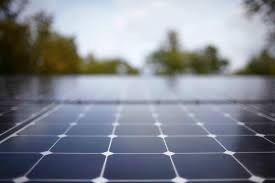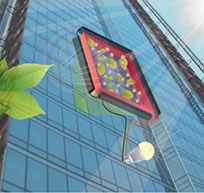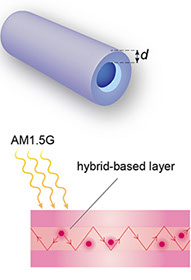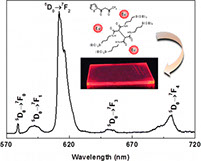


<
>
PHOTONIC HYBRIDS AND NANOMATERIALS GROUP
Aveiro-Portugal
university of aveiro
theoria poiesis praxis
physics department
ciceco
aveiro institute of materials



LUMINESCENT SOLAR CONCENTRATORS BASED ON Ln3+
Luminescent solar concentrators (LSCs) are an effective approach toward collecting sunlight economically and without additional sun trackers with potential to overcome the limiting factors of photovoltaic (PV) conversion efficiency. LSCs consist of a layer containing optically active centers deposited on a transparent substrate that, when exposed to light, converts part of the absorbing radiation into a specific emitting wavelength that will be guided to the substrate edges where it can be collected by a PV cell. LSCs can promote the integration of PV components into buildings as PV windows that would transform energy-passive building façades into large-area energy generation units solar harvesting urban furniture. A new concept on lightweight and mechanically flexible high-performance waveguiding photovoltaics was developed through the fabrication of LSCs using commercial poly(methyl methacrylate)-based plastic optical fibers coated with an Eu3+-doped organic–inorganic hybrid layer.
PEOPLE
Luís D. Carlos
Rute A. S. Ferreira
Paulo S. André
Lianshe Fu
Miguel Rodríguez
RESEARCH HIGHLIGHTS
A. R. Frias, E. Pecoraro, S. F. H. Correia, L. M. G. Minas, A. R. Bastos, S. García-Revilla, R. Balda, S. J. L. Ribeiro, P. S. André, L. D. Carlos, R. A. S. Ferreira “SSustainable luminescent solar concentrators based on organic–inorganic hybrids modified with chlorophyll” J. Mater. Chem. A, 2018,6, 8712-8723 (2018), http://dx.doi.org/10.1039/C8TA01712C
Luminescent solar concentrators (LSCs) are luminescent waveguide layers that convert sunlight into specific wavelengths which are then guided by total internal reflection to a PV device located at the edges of the LSC. Their ability to concentrate sunlight onto small areas makes LSCs a useful complement to silicon-based PVs in a series of applications, such as urban integration and flexible fabrics towards mobile solar-energy. Challenges for the luminescent layer include the use of low-cost and sustainable nature-based organic molecules. We report novel chlorophyll-based LSCs with emission properties in the red/NIR spectral region. Here, chlorophyll molecules extracted from Spirulina maxima, an abundant cyanobacterium and an attractive natural source, are immobilized in organic–inorganic di- and tri-ureasil matrices enabling the production of sustainable LSCs. At low chlorophyll concentrations (<3 × 1017 molecules per cm3), the photophysical properties of the chlorophyll molecules after incorporation into the hybrids closely resemble those in ethanolic solution (with an absolute emission quantum yield of ∼0.16 and a fluorescence lifetime of ∼8 ns). The LSCs were coupled to a Si-based commercial PV device revealing optical conversion efficiency and power conversion efficiency values of ∼3.70% and 0.10%, respectively, illustrating the potential of this approach for the development of nature-based LSCs meeting the requirements of reliable, sustainable and competitive energy systems.
S. F. H. Correia, P. P. Lima, E. Pecoraro, S. J. L. Ribeiro, P. S. André, R. A. S. Ferreira, L. D. Carlos “Scale-Up the Collection Area of Luminescent Solar Concentrators Towards Meter-Length Flexible Waveguiding Photovoltaics” Prog. Photovolt: Res. Appl. 24 1178–1193 (2016), http://dx.doi.org/10.1002/pip.2772
Luminescent solar concentrators (LSCs) are cost-effective components easily integrated in photovoltaics (PV) that can enhance solar cells' performance and promote the integration of PV architectural elements into buildings, with unprecedented possibilities for energy harvesting in façade design, urban furnishings and wearable fabrics. The devices' performance is dominated by the concentration factor (F), which is higher in cylindrical LSCs compared with planar ones (with equivalent collection area and volume). The feasibility of fabricating long-length LSCs has been essentially limited up to ten of centimetres with F < 1. We use a drawing optical fibre facility to easily scale up large-area LSCs (length up to 2.5 m) based on bulk and hollow-core plastic optical fibres (POFs). The active layers used to coat the bulk fibres or fill the hollow-core ones are Rhodamine 6G- or Eu3+-doped organic–inorganic hybrids.
S. F. H. Correia, P. P. Lima, P. S. André, R. A. S. Ferreira, L. D. Carlos, “High-efficiency Luminescent Solar Concentrators for Flexible Waveguiding Photovoltaics”, Sol. Energy Mater. Sol. Cells 138, 51–57 (2015), http://dx.doi.org/10.1016/j.solmat.2015.02.032
We presented a new concept on lightweight and mechanically flexible high-performance waveguiding photovoltaics through the fabrication of cylindrical luminescent solar concentrators (LSCs) of commercial poly(methyl methacrylate)-based plastic optical fibers coated with an Eu3+-doped organic–inorganic hybrid layer. Our optimized fiber LSC displays an effective optical conversion efficiency of 20.7±1.3% and a power conversion efficiency of 2.5±0.2% in the absorbing spectral region of the active layer (300–380 nm), values that are among the larger ones reported so far for UV-absorbing devices. Moreover, the measured optical conversion efficiency was used to calculate the self-absorption and transport efficiencies of the LSCs yielding values close to the unit. Conventional LSCs are usually made of rigid glass or plastics with limited flexibility, hampering its applicability. The approach proposed here might then open new opportunities for cost-effective sunlight collection and wearable solar-harvesting fabrics for mobile energy with negligible self-absorption and transport losses.
V. T. Freitas, L. Fu, A. M. Cojocariu, X. Cattoën, J. R. Bartlett, R. Le Parc, J.-L. Bantignies, M. Wong Chi Man, P. S. André, R. A. S. Ferreira, L. D. Carlos, “Eu3+-Based Bridged Silsesquioxanes for Transparent Luminescent Solar Concentrators”, ACS Appl. Mater. Interfaces, 7, 8770–8778 (2015), http://dx.doi.org/10.1021/acsami.5b01281
The sol–gel preparation of a bridged silsesquioxane containing europium(III) salts and 2-thenoyltrifluoroacetone has been achieved from a new ethane tetracarboxamide-based organosilane. Free-standing films with thicknesses up to 440 μm and maximum absolute quantum yield of 0.34 ± 0.03 (excitation at 320 nm) were prepared by the drop cast method, while thin films (∼200–400 nm) spin-coated on glass substrates led to highly luminescent coatings with maximum absolute quantum yield 0.60 ± 0.02 (excitation at 345 nm). The thin films were tested as planar luminescent solar concentrators and the optimized device displays an optical conversion efficiency of 12.3% in the absorbing spectral region of the active layer (300–380 nm).




MADE BY PHANTOM-G, AVEIRO, PORTUGAL
